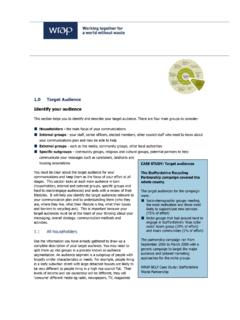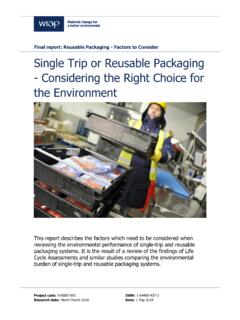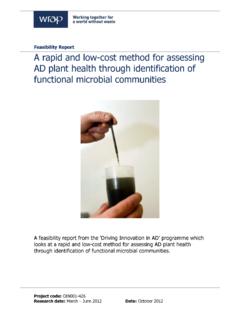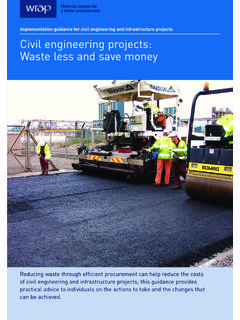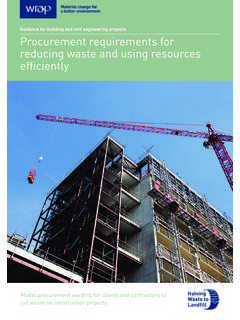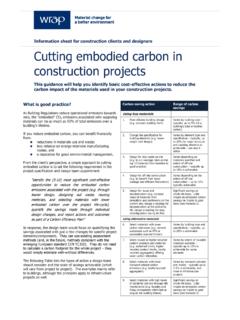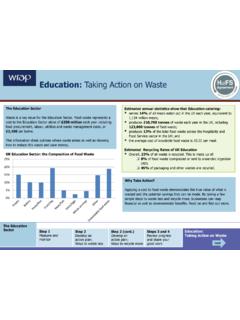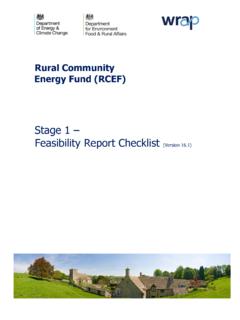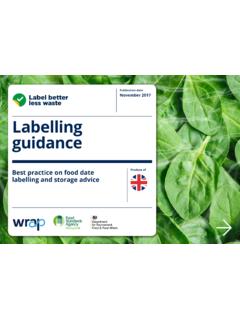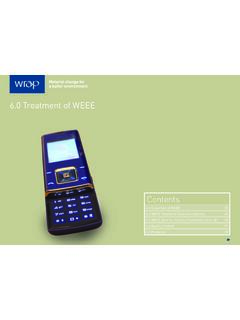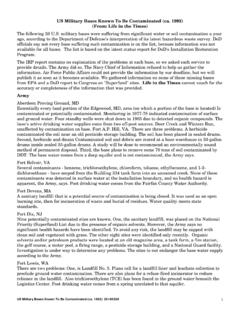Transcription of Resource efficient remediation - WRAP
1 Site at ChinnorSite at FennyStandard practiceMaterial requiring remediation9,720t31,500tVehicle movements5251,700 Cost of disposal 345,600 1,400,000 Best practice (actual)Material requiring remediation11,000t21,600tCost of site remediation 206,000 500,000 Soils transported off 0t100tsite/landfilledCost of additional 50,000 50,000site investigationAvoided cost premium 89,600 850,000for remediationAchieving savings through remediation and onsite reuse of contaminatedmaterial Bellway, Taylor Wimpey and HydrockResource efficient remediationCase studyOverviewThe remediation of sites with contaminatedsoils can be a costly and complex of Escalating landfill Tax and thepressure to demonstrate sustainability meansclients and developers are now settingrequirements for more efficient remediationsolutions and asking their designers todevelop strategies that avoid the traditional dig and dump solution. This can be the firststep in cutting the costs of waste on a case study looks at two projects thatadopted a best practice approach to MaterialsManagement Planning, in accordance withCL:AIRE s recently published Definition ofWaste: Development Industry Code ofPractice.
2 In each case, the developerbenefited from substantial reductions in cost,shortened programmes and reduced impacton the local case study looks at: Chinnor Cement Works 77ha, requiring ademolition, reclamation and remediationstrategy; and the former BPC & Wheelspan site at Fenny a remediation scheme in a tighturban work illustrates how CL:AIRE s Code ofPractice can help to deliver practical :AIRE (Contaminated Land:Applications in Real Environments) is anorganisation established to stimulate theregeneration of contaminated land byraising awareness of, and confidence in,practical and sustainable remediationtechnologies. The Code of Practiceprovides a structured approach to the reuse of soils on site, and provides a clearprocess for the project team indetermining whether excavated materialsare a waste. It is applicable in Englandand Wales. Costs and savings achieved by housing developers on two remediation sites through adopting an efficient remediation strategyHalving Waste to landfill Case study: Resource - efficient remediationChinnor Cement WorksThe site at Chinnor is a 77ha former cementworks, cement kiln dust landfill and series ofchalk quarries, with a proportion of the site(7ha) identified as an area for residentialdevelopment.
3 The site is located above amajor chalk aquifer and spring system, withprevious site investigations indicating thatpetroleum hydrocarbons (primarily fromleaking fuel tanks) were present within boththe soils and the groundwater. The challengeChinnor is located on the edge of a villagewith poor access and resultant concerns fromthe public over the impact of demolition, remediation and development of the of the level of contaminants (whichincluded petroleum hydrocarbon andpolycyclic aromatic hydrocarbons) and theneed to protect the local aquifer Resource , theoriginal remedial strategy suggested that9,720t (~5,400m3)1of soils would requiredisposal off-site rather than on siteremediation. This solution was rejected as itwould have required~525 vehicle movements,would be expensive, and impact heavily onthe local community. The challenge was tofind a solution that allowed materials toremain on site in a way that enabledsubsequent re-development (residential andcommercial) and at the same time mitigatedthe risk to the local chalk approachThe client (Taylor Wimpey) instructedHydrock to carry out an appraisal of theprevious site investigations/risk assessment,remedial strategy and costs.
4 Early on,Hydrock identified gaps in the previous riskassessment and noted that the remedialstrategy (dig and dump) was bothunsustainable and costly. Taylor Wimpeywas aware of the potential to save moneythrough alternative solutions and instructedthe design team to explore these. The site investigation works were carried outfollowed by a detailed hydrogeologicalassessment, groundwater risk assessment,human health risk assessment and remedialstrategy in order to develop and refine theConceptual Site Model. The Model is asimplified representation of the siteconditions including geology, hydrogeologyand any significant pollution consideration was given to the finaldevelopment plan and the cut & fillrequirements, which helped the formulationof a viable remediation strategy and robustMaterial Management Plan. (This Plan isintegral to the Code of Practice and can formpart of the Site Waste Management Plan.)On site remediation techniques (using bothbioremediation and soilstabilisation/solidification) were proposed forthe impacted soils, as opposed to anexcavation and disposal option.
5 Uponfurther characterisation and testing, only6,300t (~3,500m3) of materials requiredtreatment, with the remainder suitable forreuse without treatment. 1 Based on 1m3= assessmentMaterial requiring 9,720tremediation off siteVehicle movements525 Cost of disposal 345,600 Final designMaterial requiring 11,000tremediation or reuse on siteCost of site remediation 206,000 Soils transported off 0tsite/landfilledCost of additional 50,000site investigationSummaryCost premium (avoided) for 89,600dig and dump solutionCost premium (avoided) 97,777through import of new materialOnce the revised strategy was agreed withthe regulators, Hydrock developed a MaterialManagement Plan that took into account thevolume of material produced by the followingactivities and identified areas within the sitewhere these soil volumes could be suitably re used: demolition arisings; remediation volumes; cut & fill requirements; and soil use in the final development addition, all metal from the demolition ofabove-ground structures was study: Resource - efficient remediationThis Table shows the scale of the savings that wereachieved, resulting both from the avoidance of landfill ,and the avoidance of imported BPC & Wheelspan Site (Fenny)This small site ( ) is located in a sensitiveresidential area in Milton Keynes.
6 The sitewas to be developed for residential use, withgardens and areas of public open space. It isbounded on one side by a canal and on theother side by a river (the main receptor), andin its history has had numerous former usesincluding: former town gasworks; paint pigment factory; and a transport client, Bellway NHC, was aware of thecost premium of a traditional (dig and dump)remedial strategy. Hydrock was instructed tocarry out further site investigation and designa scheme that avoided a dig and dumpsolution and as such the associated challengePrevious site investigations indicated site-wide gross contamination including: gasworks waste: - petroleum hydrocarbons; - running tars; - polycyclic aromatic hydrocarbons; - heavy metals; - cyanides; and cadmium impacted soils from paint to the proximity of the river and the highlevel of contamination, the EnvironmentAgency s original preferred strategy was toremove all grossly contaminated soils andinstall an impermeable barrier to preventsubsequent contamination of the river.
7 Thefeasibility study identified that this solutionwould have required the excavation anddisposal of between 27,000t 36,000t(15,000m3to 20,000m3) of largely hazardousmaterials to a landfill 70-80 miles away. Thiswas considered neither economically viablenor sustainable. A Material Management Plan provides adescription of the materials in terms ofpotential use and relative quantities ofeach category, details of where and howthese materials are to be stored, detailsof the final destination of the material,details of the material tracking system( from excavation to re-compaction)and any contingency arrangements (forexample if more material is found).Case study: Resource - efficient remediationThe approachAdditional site investigations were undertakento ascertain the full extent of impacted soils(including treatment trials). This also allowedrevised human health and groundwater riskassessments to be carried out, resulting in arobust Conceptual Site Model which waspresented to the Regulators.
8 This included arevised hydrogeological assessment andpotential migration pathways, in addition tothe further delineation of gross contaminationlocations. This allowed Hydrock to review theoriginal remedial proposal and construct amore sustainable and economically robust remedial strategy and MaterialManagement Plan was then formulated thatincluded the treatment (soilstabilisation/solidification) and re use ofimpacted soils on site. Lab-scale treatmenttrials were presented to the EnvironmentAgency who agreed the new also re-evaluated site levels andagreed a revised strategy with Bellway,allowing more soils to be retained on works involved the selective excavation ofgrossly impacted soils for ex-situ treatmentusing soil stabilisation/ solidificationtechnology. Impacted groundwater was usedin the soil stabilisation process or treatedseparately for regulated discharge to the foulsewer. Upon validation of the soil stabilisationprocess, treated soils were replaced andcompacted in suitable fill areas.
9 Works werephased to allow Bellway to begin constructionworks on a proportion of the site, whilst stillundertaking remedial works in other areas. Prior to remediation , all hardstanding,foundations and in-ground obstructions wereremoved and crushed for re use on the the benefit of the site trials, soilstabilisation/solidification was carried out onboth the cadmium impacted soils and thegasworks impacted soils (both of which wereUK firsts for the material type), enabling a100% retention rate on site for these soils of aformerly hazardous adoption of the Material ManagementPlan and remedial strategy, which focused onmitigating the risks posed to the nearby river,allowed the re use of the materials on sitebelow hardstanding ( car parks, footpaths)and in road site re use of materials as non-waste wasin accordance with the procedures set out inthe newly published Code of Practice they were suitable for use without anyfurther treatment; they had certainty of use.
10 And there was space available for the materialon assessmentMaterial requiring 31,500tremediationVehicle movements1,700 Cost of disposal 1,400,000 Final designMaterial requiring 21,600tremediationCost of site remediation 500,000 Soils transported off 0tsite/landfilledCost of additional 50,000site investigationSummaryCost premium (avoided) for 850,000dig and dump solutionCost premium (avoided) 192,000through import of new materialCase study: Resource - efficient remediationWaste & ResourcesAction ProgrammeThe Old Academy21 Horse FairBanbury, OxonOX16 0 AHTel: 01295 819 900 Fax: 01295 819 911E-mail: freephone0808 100 2040 While steps have been taken to ensure its accuracy, WRAP cannot accept responsibility or be held liable to any person for any loss or damage arising outof or in connection with this information being inaccurate, incomplete or misleading. This material is copyrighted. It may be reproduced free of chargesubject to the material being accurate and not used in a misleading context.
